
Hãy nhập câu hỏi của bạn vào đây, nếu là tài khoản VIP, bạn sẽ được ưu tiên trả lời.


\(a,\dfrac{12}{5}=\dfrac{x}{1,5}\Rightarrow x=\dfrac{12\cdot1,5}{5}=3,6\\ b,\dfrac{x}{5}=\dfrac{3}{20}\Rightarrow x=\dfrac{5\cdot3}{20}=\dfrac{3}{4}\\ c,\dfrac{4}{x}=\dfrac{10}{9}\Rightarrow x=\dfrac{4\cdot9}{10}=\dfrac{18}{5}\\ d,\Rightarrow\dfrac{x}{15}=\dfrac{60}{x}\Rightarrow x^2=60\cdot15=900\Rightarrow\left[{}\begin{matrix}x=30\\x=-30\end{matrix}\right.\\ 2,\)
a, Áp dụng t/c dtsbn:
\(\dfrac{x}{3}=\dfrac{y}{5}=\dfrac{z}{6}=\dfrac{x+y-z}{3+5-6}=\dfrac{8}{2}=4\\ \Rightarrow\left\{{}\begin{matrix}x=12\\y=20\\z=24\end{matrix}\right.\)
b, Áp dụng t/c dtsbn:
\(\dfrac{x}{3}=\dfrac{y}{5}=\dfrac{z}{6}=\dfrac{x-y+z}{3-5+6}=\dfrac{-4}{4}=-1\\ \Rightarrow\left\{{}\begin{matrix}x=-3\\y=-5\\z=-6\end{matrix}\right.\)
c, Áp dụng t/c dtsbn:
\(\dfrac{x}{3}=\dfrac{y}{5}=\dfrac{z}{6}=\dfrac{2y}{10}=\dfrac{3z}{18}=\dfrac{x-2y+3z}{3-10+18}=\dfrac{-33}{11}=-3\\ \Rightarrow\left\{{}\begin{matrix}x=-9\\y=-15\\z=-18\end{matrix}\right.\)
d, Đặt \(\dfrac{x}{3}=\dfrac{y}{5}=\dfrac{z}{6}=k\Rightarrow x=3k;y=5k;z=6k\)
\(x^2-4y^2+2z^2=-475\\ \Rightarrow9k^2-100k^2+72z^2=-475\\ \Rightarrow-19k^2=-475\\ \Rightarrow k^2=25\Rightarrow\left[{}\begin{matrix}k=5\\k=-5\end{matrix}\right.\\ \Rightarrow\left[{}\begin{matrix}x=15;y=25;z=30\\x=-15;y=-25;z=-30\end{matrix}\right.\)

a) Áp dụng tính chất dãy tỉ số bằng nhau ta có:
\(\dfrac{x}{5}=\dfrac{y}{2}=\dfrac{z}{-3}=\dfrac{x.y.z}{5.2.-3}=\dfrac{240}{-30}=-8\)
\(\Rightarrow\dfrac{x}{5}=-8\Rightarrow x=-8.5=-40\)
\(\Rightarrow\dfrac{y}{2}=-8\Rightarrow y=-8.2=-16\)
\(\Rightarrow\dfrac{z}{-3}=-8\Rightarrow z=-8.-3=24\)
Vậy \(x=--40;y=-16\) và \(z=24\)
b) Áp dụng tính chất dãy tỉ số bằng nhau ta có:
\(\dfrac{x}{3}=\dfrac{y}{4}=\dfrac{z}{2}=\dfrac{x^3-y^3+z^3}{3^3-4^3+2^3}=\dfrac{-29}{-29}=1\)
\(\Rightarrow\dfrac{x}{3}=1\Rightarrow x=3.1=3\)
\(\Rightarrow\dfrac{y}{4}=1\Rightarrow y=1.4=4\)
\(\Rightarrow\dfrac{z}{2}=1\Rightarrow z=1.2=2\)
Vậy \(x=3;y=4\) và \(z=2\)

`#3107.101117`
a)
`x \div y \div z = 4 \div 3 \div 9`
`=> x/4 = y/3 = z/9`
`=> x/4 = (3y)/9 = (4z)/36`
Áp dụng tính chất dãy tỉ số bằng nhau ta có:
`x/4 = (3y)/9 = (2z)/8 = (x - 3y + 4z)/(4 - 9 + 36) = 62/31 = 2`
`=> x/4 = y/3 = z/9 = 2`
`=> x = 4*2 = 8` $\\$ `y = 3*2 = 6` $\\$ `z = 9*2 = 18`
Vậy, `x = 8; y = 6; z = 18`
c)
\(x \div y \div z = 1 \div 2 \div 3\)
`=> x/1 = y/2 = z/3`
`=> (4x)/4 = (3y)/6 = (2z)/6`
Áp dụng tính chất dãy tỉ số bằng nhau ta có:
`(4x)/4 = (3y)/6 = (2z)/6 = (4x - 3y + 2z)/(4 - 6 + 6) = 36/4 = 9`
`=> x/1 = y/2 = z/3 = 9`
`=> x = 1*9=9` $\\$ `y = 2*9 = 18` $\\$ `z = 3*9 = 27`
Vậy, `x = 9; y = 18; z = 27`
Các câu còn lại cậu làm tương tự nhé.

a: 3x=7y
=>x/7=y/3=(x-y)/(7-3)=-16/4=-4
=>x=-28; y=-12
b: x/6=y/5
=>x/6=2y/10=(x+2y)/(6+10)=20/16=5/4
=>x=30/4=15/2; y=25/4
c: Áp dụng tính chất của DTSBN, ta được:
\(\dfrac{x}{2}=\dfrac{y}{-3}=\dfrac{z}{5}=\dfrac{2x+3y+5z}{2\cdot2+3\cdot\left(-3\right)+5\cdot5}=\dfrac{6}{20}=\dfrac{3}{10}\)
=>x=3/5; y=-9/10; z=3/2
d: x/2=y/3
=>x/8=y/12
y/4=z/5
=>y/12=z/15
=>x/8=y/12=z/15
Áp dụng tính chất của DTSBN, ta được:
\(\dfrac{x}{8}=\dfrac{y}{12}=\dfrac{z}{15}=\dfrac{x+y-z}{8+12-15}=\dfrac{10}{5}=2\)
=>x=16; y=24; z=30

Bài 1:
a) Ta có: \(\dfrac{17}{6}-x\left(x-\dfrac{7}{6}\right)=\dfrac{7}{4}\)
\(\Leftrightarrow\dfrac{17}{6}-x^2+\dfrac{7}{6}x-\dfrac{7}{4}=0\)
\(\Leftrightarrow-x^2+\dfrac{7}{6}x+\dfrac{13}{12}=0\)
\(\Leftrightarrow-12x^2+14x+13=0\)
\(\Delta=14^2-4\cdot\left(-12\right)\cdot13=196+624=820\)
Vì Δ>0 nên phương trình có hai nghiệm phân biệt là:
\(\left\{{}\begin{matrix}x_1=\dfrac{14-2\sqrt{205}}{-24}=\dfrac{-7+\sqrt{205}}{12}\\x_2=\dfrac{14+2\sqrt{2015}}{-24}=\dfrac{-7-\sqrt{205}}{12}\end{matrix}\right.\)
b) Ta có: \(\dfrac{3}{35}-\left(\dfrac{3}{5}-x\right)=\dfrac{2}{7}\)
\(\Leftrightarrow\dfrac{3}{5}-x=\dfrac{3}{35}-\dfrac{10}{35}=\dfrac{-7}{35}=\dfrac{-1}{5}\)
hay \(x=\dfrac{3}{5}-\dfrac{-1}{5}=\dfrac{3}{5}+\dfrac{1}{5}=\dfrac{4}{5}\)

b: Áp dụng tính chất của dãy tỉ số bằng nhau, ta được:
\(\dfrac{x-1}{2}=\dfrac{y+3}{4}=\dfrac{z-5}{6}=\dfrac{-3x-4y+5z+3-12-25}{-3\cdot2-4\cdot4+5\cdot6}=\dfrac{16}{8}=2\)
Do đó: x=5; y=5; z=17
\(a,\dfrac{x^3}{8}=\dfrac{y^3}{27}=\dfrac{z^3}{64}\Rightarrow\dfrac{x}{2}=\dfrac{y}{3}=\dfrac{z}{4}\Rightarrow\dfrac{x^2}{4}=\dfrac{y^2}{9}=\dfrac{z^2}{16}\)
Áp dụng t/c dtsbn:
\(\dfrac{x^2}{4}=\dfrac{y^2}{9}=\dfrac{z^2}{16}=\dfrac{x^2+2y^2-3z^2}{4+18-48}=\dfrac{-650}{-26}=25\\ \Rightarrow\left\{{}\begin{matrix}x^2=100\\y^2=225\\z^2=400\end{matrix}\right.\Rightarrow\left\{{}\begin{matrix}x=\pm10\\y=\pm15\\z=\pm20\end{matrix}\right.\)
Vậy \(\left(x;y;z\right)\) có giá trị là hoán vị của \(\left(\pm10;\pm15;\pm20\right)\)

Bài 2:
a: =>x=0 hoặc x=-3
b: =>x-2=0 hoặc 5-x=0
=>x=2 hoặc x=5
c: =>x-1=0
hay x=1

a. Theo t/c của dãy tỉ số bằng nhau ta có:
x+y+z/2+3+5=40/10=4
=>x=4.2=8
=>y=4.3=12
=>z=4.5=20
b: Áp dụng tính chất của dãy tỉ số bằng nhau, ta được:
\(\dfrac{x}{2}=\dfrac{y}{3}=\dfrac{z}{5}=\dfrac{x-3y+2z}{2-3\cdot3+2\cdot5}=\dfrac{9}{-15}=\dfrac{-3}{5}\)
Do đó: \(\left\{{}\begin{matrix}x=-\dfrac{6}{5}\\y=\dfrac{-9}{5}\\z=-3\end{matrix}\right.\)

d: Áp dụng tính chất của dãy tỉ số bằng nhau, ta được:
\(\dfrac{x}{\dfrac{1}{2}}=\dfrac{y}{\dfrac{1}{3}}=\dfrac{z}{\dfrac{1}{4}}=\dfrac{x+3y-2z}{\dfrac{1}{2}+3\cdot\dfrac{1}{3}-2\cdot\dfrac{1}{4}}=\dfrac{36}{1}=36\)
Do đó: x=18; y=12; z=9

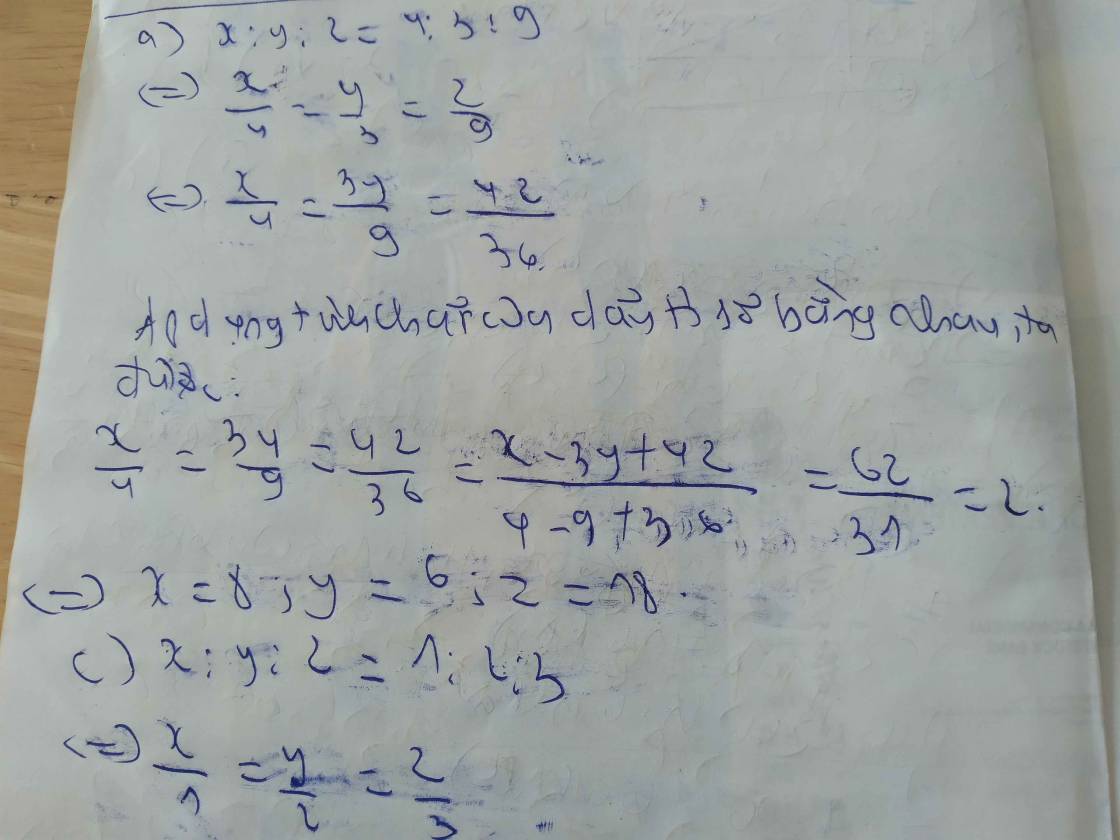
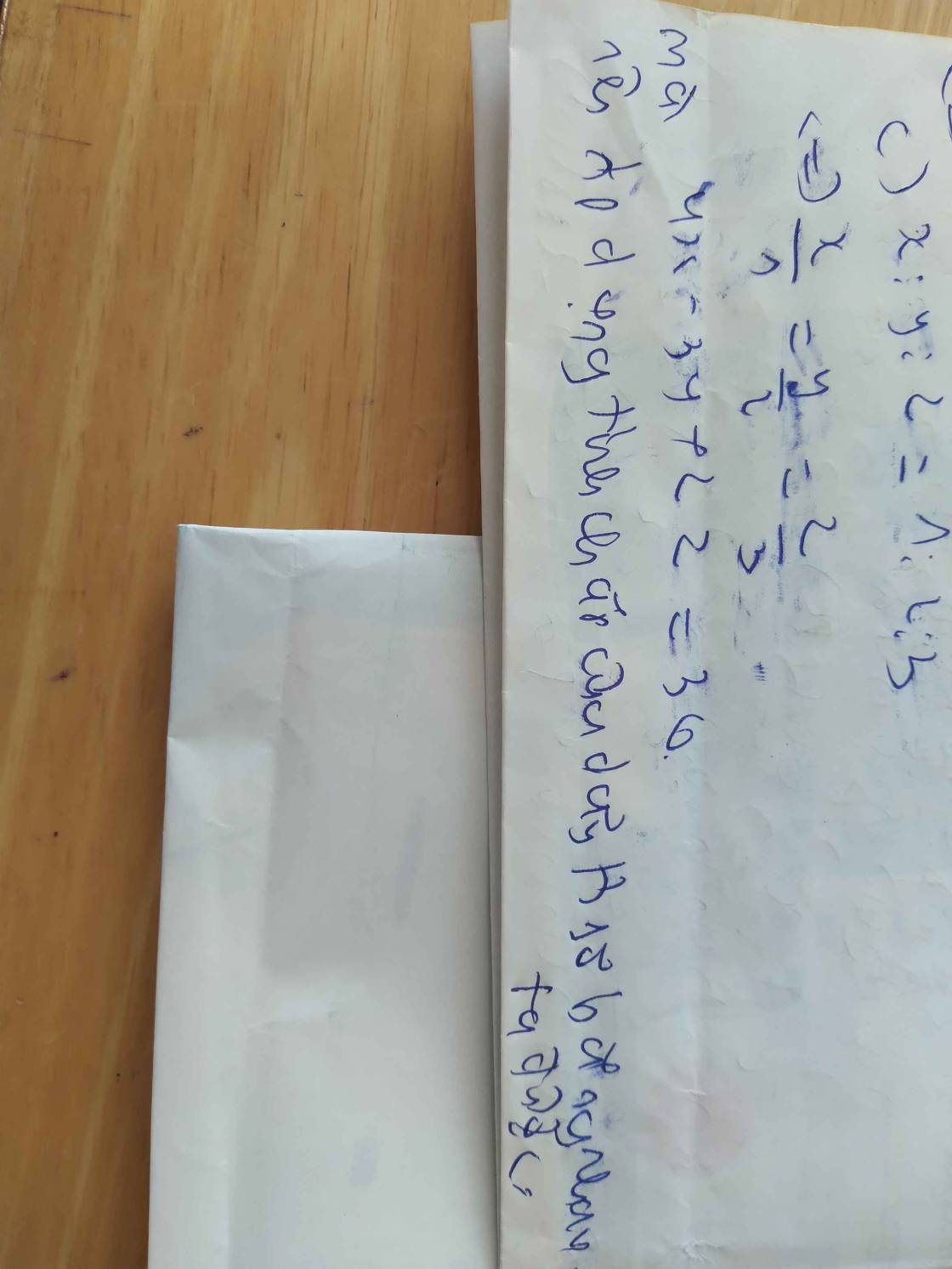
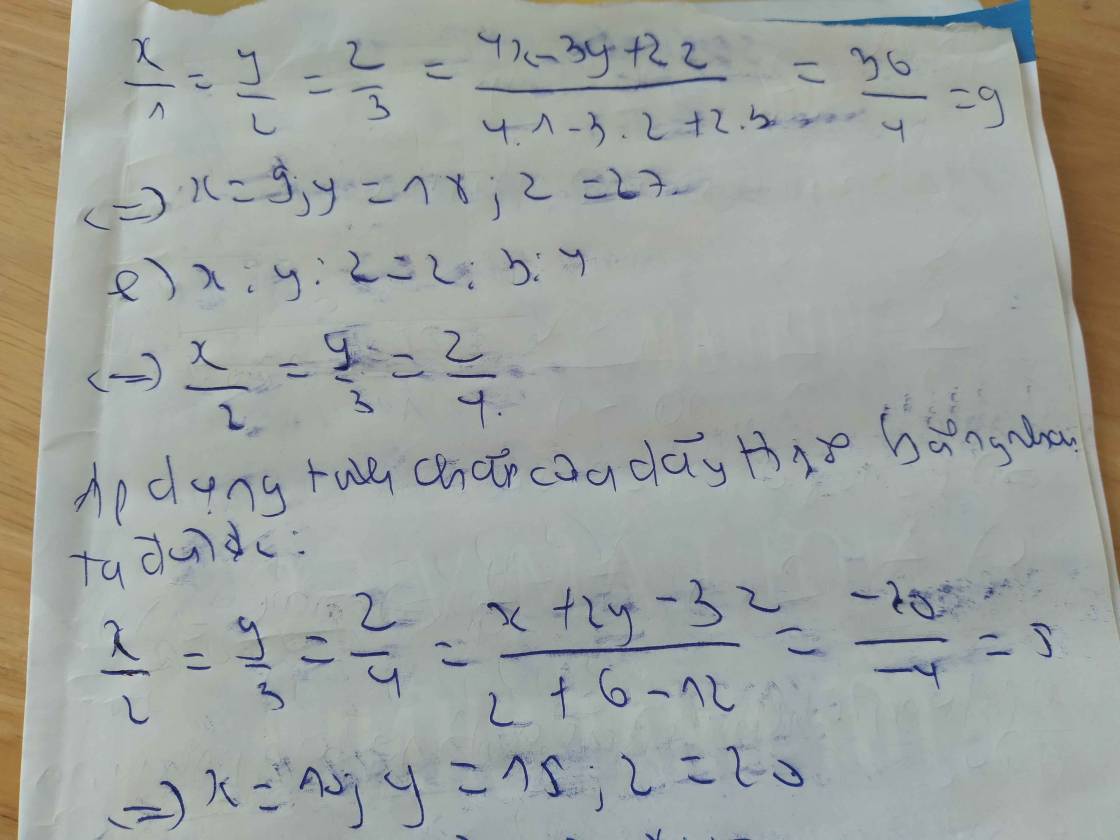
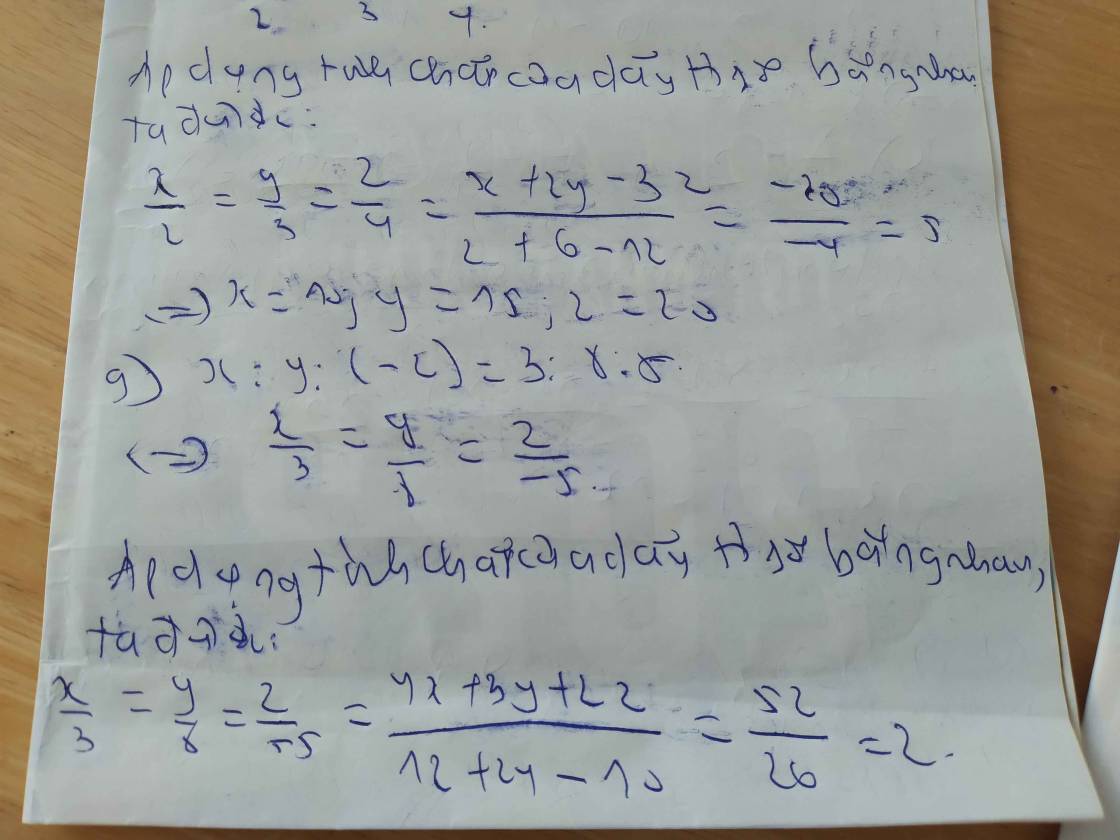
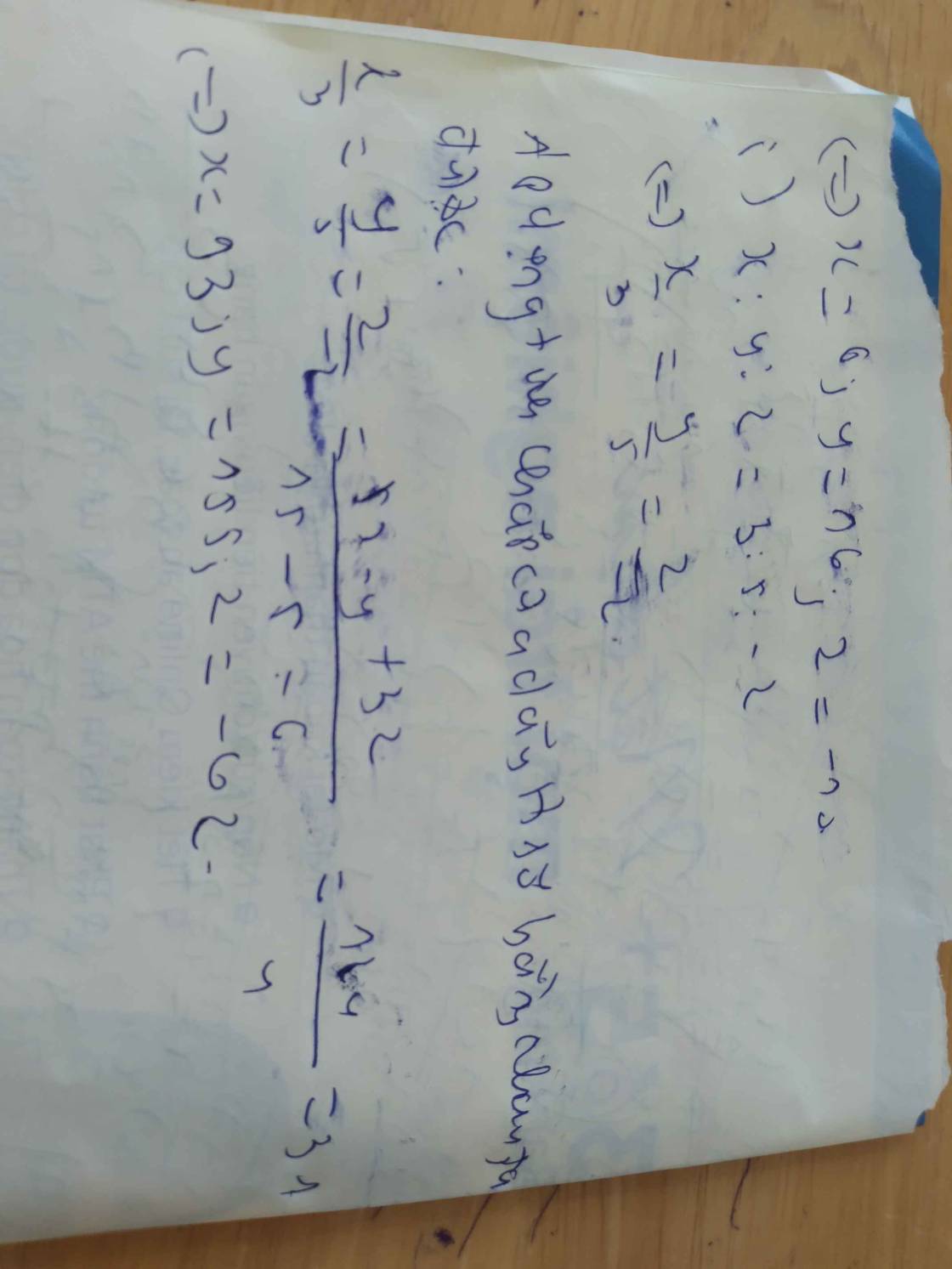
a) ( x - 1 ) . ( y + 2) = 5 = 1.5 = 5 . 1 = (-1) . (-5) = (-5) . (-1)
Xét 4 trường hợp ta có :
\(\left(1\right)\hept{\begin{cases}x-1=1\\y+2=5\end{cases}\Rightarrow\hept{\begin{cases}x=2\\y=3\end{cases}}}\)
\(\left(2\right)\hept{\begin{cases}x-1=5\\y+2=1\end{cases}\Rightarrow\hept{\begin{cases}x=6\\y=-1\end{cases}}}\)
\(\left(3\right)\hept{\begin{cases}x-1=-1\\y+2=-5\end{cases}\Rightarrow\hept{\begin{cases}x=0\\y=-7\end{cases}}}\)
\(\left(4\right)\hept{\begin{cases}x-1=-5\\y+2=-1\end{cases}\Rightarrow\hept{\begin{cases}x=-4\\y=-3\end{cases}}}\)
\(\left(x-1\right)\left(y+2\right)=5\)
\(Th1:\hept{\begin{cases}x-1=5\\y+2=5\end{cases}}\Rightarrow\hept{\begin{cases}x=6\\y=3\end{cases}}\)
\(Th2:\hept{\begin{cases}x-1=-5\\y+2=-5\end{cases}}\Rightarrow\hept{\begin{cases}x=-4\\y=-7\end{cases}}\)